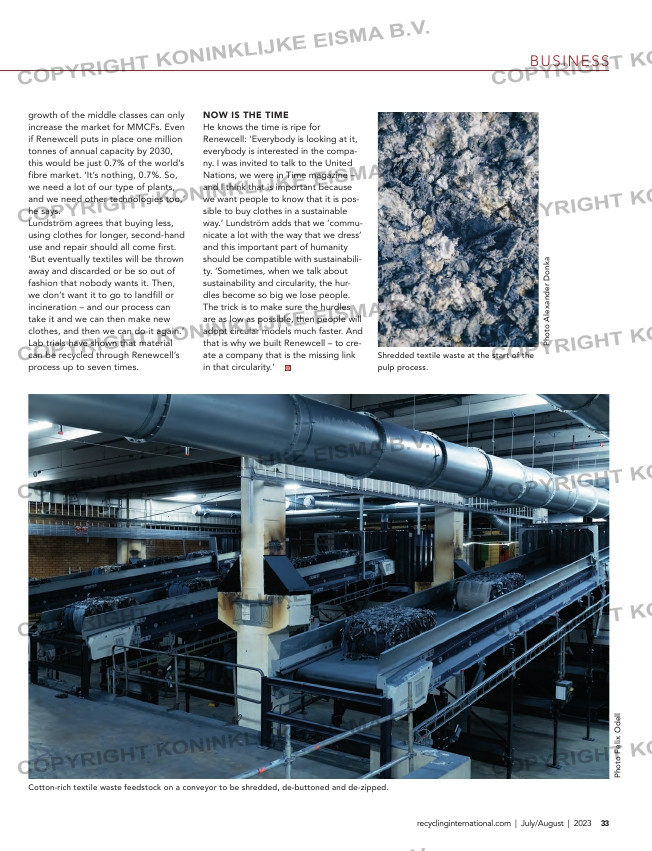Page 33 from: Recycling International – July/August issue 2023

BUSINESS
33recyclinginternational.com | July/August | 2023
growth of the middle classes can only
increase the market for MMCFs. Even
if Renewcell puts in place one million
tonnes of annual capacity by 2030,
this would be just 0.7% of the world’s
fibre market. ‘It’s nothing, 0.7%. So,
we need a lot of our type of plants,
and we need other technologies too,’
he says.
Lundström agrees that buying less,
using clothes for longer, second-hand
use and repair should all come first.
‘But eventually textiles will be thrown
away and discarded or be so out of
fashion that nobody wants it. Then,
we don’t want it to go to landfill or
incineration – and our process can
take it and we can then make new
clothes, and then we can do it again.’
Lab trials have shown that material
can be recycled through Renewcell’s
process up to seven times.
NOW IS THE TIME
He knows the time is ripe for
Renewcell: ‘Everybody is looking at it,
everybody is interested in the compa-
ny. I was invited to talk to the United
Nations, we were in Time magazine –
and I think that is important because
we want people to know that it is pos-
sible to buy clothes in a sustainable
way.’ Lundström adds that we ‘commu-
nicate a lot with the way that we dress’
and this important part of humanity
should be compatible with sustainabili-
ty. ‘Sometimes, when we talk about
sustainability and circularity, the hur-
dles become so big we lose people.
The trick is to make sure the hurdles
are as low as possible, then people will
adopt circular models much faster. And
that is why we built Renewcell – to cre-
ate a company that is the missing link
in that circularity.’
chain, such as Chinese viscose fibre
manufacturer Tangshan Sanyou which
has been working with Renewcell
since 2018. Tangshan Sanyou plans to
offer commercial quantities of fibres
made from 100% Circulose in 2024. A
four-year supply agreement has also
been agreed with fibre manufacturer
Lenzing.
MATCHES VIRGIN
Circulose is a direct replacement for
virgin raw material for the MMCF mar-
ket. ‘We are a “drop in” to the exist-
ing value chain and our customers
don’t have to change,’ Lundström
explains. He adds that there is ‘no
trade-off’ with using Circulose com-
pared to other man-made cellulosic
materials. It looks and feels like virgin
material, can compete on cost, and
has already been successfully used in
garments produced for big names
including Levi’s and H&M.
In April, Renewcell 1 produced 1 700
tonnes and by the end of the year it
should be producing 5 000 tonnes a
month – equivalent to 60 000 tonnes a
year. Plans are in place to double the
plant’s annual capacity to 120 000
tonnes in 2024. By 2025, the company
wants an annual capacity of 360 000
tonnes.
Lundström has a vision for ‘a plant
in each major geography’, including
the US, Asia and ‘potentially even
in Africa’ as plants are best located
either near their raw material
supply or the customer – or preferably
both.
DRIVING CHANGE
As well as demand for sustainable
fashion from consumers, brands and
investors, legislation across the world
is driving change. In the EU, textiles
waste must be separately collected by
2025. Last year, the EU Strategy for
Sustainable and Circular Textiles was
published, and the US passed The
Inflation Reduction Act, focused on
transitioning to a greener economy.
Lundström estimates that Renewcell,
which is publicly listed, is up to seven
years ahead of competition. But he
welcomes more operators because
worldwide population growth and the Cotton-rich textile waste feedstock on a conveyor to be shredded, de-buttoned and de-zipped.
Shredded textile waste at the start of the
pulp process.
Ph
ot
o
Fe
lix
O
de
ll
Ph
ot
o
A
le
xa
nd
er
D
on
ka
30-31-32-33_smarttextiles-sweden.indd 33 05-07-2023 11:49



